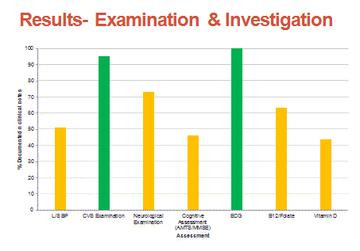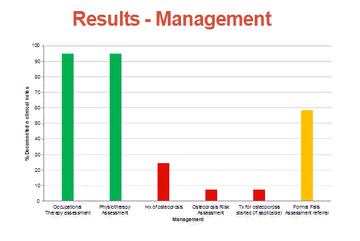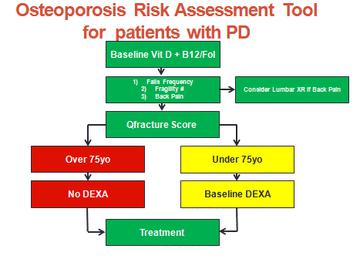Inpatients falls assessment and Parkinsonism
Two thirds of Parkinson’s disease (PD) patients fall each year and many experience recurrent falls. Several motor and non-motor complications of Parkinson’s disease and other comorbidities contribute to these falls. NICE guidelines recommends PD patients should have detailed falls assessment. Falls result in fragility fractures, hence osteoporosis risk assessment is important. Osteoporosis is common in PD patients affecting up to 91% of women and 61% men¹.
Audit design
This was a retrospective review of hospital records of Parkinsonism patients admitted following a fall/falls to West Suffolk Hospital from June to September 2015. We documented falls assessment compared with NICE falls guidelines. In addition basic examination, investigations, osteoporosis risk assessment and treatment were also reviewed. Forty one patient records were reviewed using an audit pro forma. Two patients had possible vascular parkinsonism.
Data analysis
Sex: Male 28, Female 13
Average Age: 81.3 years, Range: 61-98 years
Medicine: 34 Surgery: 3 A&E/CDU: 4
Average number of medications on admission: 7 (Range 1-17)




Recommendations
- Introduce a protocol for formal falls risk assessment for Parkinsonism patients with a particular emphasis on basic clinical examination, investigations and osteoporosis risk assessment.
- Educate and remind nurses and clinicians about the importance of basic clinical examination, falls investigations and importance of bone prophylaxis in PD patients by means of meetings and regular teachings.
- Introduce a routine protocol of performing osteoporosis risk assessment tool for in and out patients of Parkinson’s disease(Please see graph 4).
- Introduce a falls risk assessment protocol for multi-disciplinary PD clinic.
- Improve recognition and treatment of urinary incontinence and cognitive problems in patients with Parkinson’s disease.
- Repeat the audit with a larger sample size after 12 months.
2016 update
We have started using falls assessment tool for in and out patients with falls. We have also presented the audit in the hospital clinical governance meeting in order to educate and remind medical teams. Parkinson’s specialist nurse will continue to educate nursing and other health care professionals about importance of falls assessment. ( i.e. continence assessment,L/S BP measurement etc). We have had a poster presentation at the recently concluded (29 January 2016) BritMODIS meeting in Birmingham.
References
- Invernizzi, M., Carda, S., Viscontini, G. S. & Cisari, C. Osteoporosis in Parkinson’s disease. Parkinsonism & Related Disorders 15, 339–346 (2009).
- Genever, R. W., Downes, T. W. & Medcalf, P. Fracture rates in Parkinson’s disease compared with age- and gender-matched controls: a retrospective cohort study. Age and Ageing 34, 21 –24 (2005).
- NICE guidelines –Parkinson’s Disease (2006) and Falls (2004).
- Lyell, V, Henderson, E, Devine, M & Gregson, ‘Assessment and management of fracture risk in patients with Parkinson’s disease’. Age and Ageing 44,34-41(2014).
- Vestergaard, P., Rejnmark, L. & Mosekilde, L. Fracture risk associated with parkinsonism and anti-Parkinson drugs. Calcif. Tissue Int. 81, 153–161 (2007).
- Allen NE, SCHWARZEL AK, CANNING CG; Recurrent falls in Parkinson’s disease: a systematic review; PARKINSON’S DISEASE, Article ID:906274.(2013)
More Parkinson's Academy Falls & bone health Projects
'The things you can't get from the books'
Parkinson's Academy, our original and longest running Academy, houses 23 years of inspirational projects, resources, and evidence for improving outcomes for people with Parkinson's. The Academy has a truly collegiate feel and prides itself on delivering 'the things you can't get from books' - a practical learning model which inspires all Neurology Academy courses.